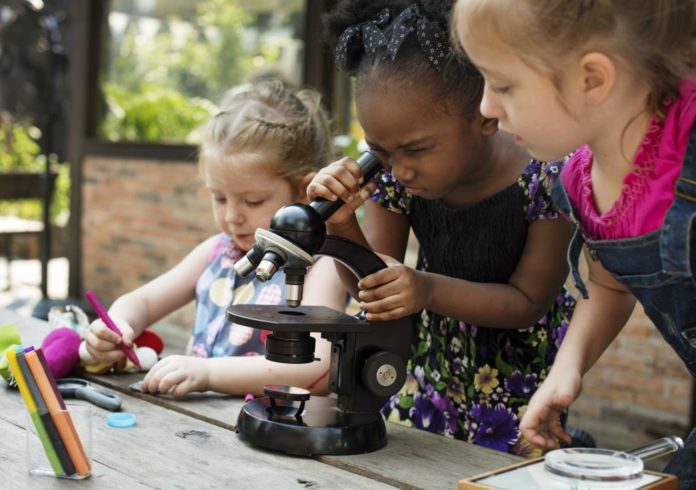Hardly a day goes by that parents aren’t reminded that their kids need to be up to speed with – if not downright excelling in – STEM courses (Science, Technology, Engineering, and Mathematics). In an increasingly digital world, that’s where all the jobs are, where the future lies.
But a number of learning experts caution that STEM alone can actually be limiting to kids. Their reasoning goes something like this: STEM helps kids to develop the rigorous skills they need to understand and compete in today’s world.
But art enables kids to tap into a different part of their consciousness (or brain, if you prefer), and imagine news ways of interpreting the world and solutions to complex problems. By combining STEM with art – known in some circles as STEAM – kids are provided with the best possible combination of problem-solving capacities and skills.
art has the role in education of helping children become like themselves instead of more like everyone else.
Or as famed dancer Heather Watts says, “Arts education is a big part of building a 21st century creative mind, and I think that we have let way too many kids lose their way by not drawing in their young minds with music, dance, painting and the other various ways we can express those things we do not have words for.”
A generation ago, Daniel Goleman captured the nation’s attention with his groundbreaking book on emotional intelligence. In it, Goleman argued that our emotional intelligence was at least as important – if not more so – than our intellectual intelligence.
And what are the hallmarks of the emotionally intelligent child?
Self-Awareness
This is a person’s ability to identify and understand their moods, emotions, etc., and their impact on others. The self-aware are more confident, have realistic ideas about themselves, and use self-deprecating humor. “Art,” declared early education expert Sydney Gurewitz Clemens, “has the role in education of helping children become like themselves instead of more like everyone else.”
Self-Control
Because they are more self-aware, these individuals are better able to control and redirect their emotions and impulses or to suspend judgment without acting. As a result, they’re more comfortable in unfamiliar or chaotic environments and are more open to change.
Self-Motivated
An emotionally intelligent individual is more likely to march to an internal drummer and work for herself more than position, money, or fame. They are curious, find many subjects of interest, have a strong desire to achieve their dreams, and are optimistic even in the face of challenges or failures.
Empathetic
Goleman felt that an individual’s capacity to understand and relate to the emotional makeup of other human beings was particularly important. This enables them to get along with just about anyone, increases their cultural sensitivity, and makes them more successful in building and leading teams.
Social
Due to the aforementioned traits, the emotionally intelligent are particularly adept at interpersonal relationships, be they at home, work, or the community. These individuals are more likely to lead efforts toward positive change, be persuasive, and excel at networking and leadership.
Putting the Art in STEM
OK, so what’s all this got to do with art, music, and dance? Simply put, the arts put children in touch with something other than just their intellect. Rather than mastering complex topics such as trigonometry or biology, children are encouraged to develop skills that, over time, improve their emotional intelligence.
For example, a child who masters the Periodic Table will indeed have a good handle on the basics of chemical law. But a child who masters the role of the pauper in “The Prince and the Pauper,” learns empathy (gets in the head of his character), social networking (is part of a carefully choreographed troupe), and self-control (summons and directs emotions in the best way possible). Similar or different traits for emotional intelligence are learned through participation in orchestra, marching band, art, etc.
Unfortunately, the arts often are the first programs to be cut by financially-strapped school systems under pressure from both lawmakers and citizens to produce more STEM-enabled children. The result may indeed be children more proficient in math and science. But they may struggle to work well with others, form healthy interpersonal bonds, recognize and control their emotions, and relate to those around them.
What is perhaps most important to recognize is that the healthiest, happiest, and most successful children are those where both sides of the brain are nurtured and developed. Studies have demonstrated that children asked to solve problems in areas where they are particularly gifted show increased electrical activity across both hemispheres of the brain, not just one side.
Specific benefits of the arts are too numerous to list here, but according Kimberly Sheridan of the New York Center for Arts Education, children who participate in the arts are more able to:
- Observe the world, dump any preconceptions, and envision something entirely novel
- Use their own imagination and voice to express themselves vs repeating rote learning
- Tackle difficult challenges and persist despite setbacks
- Reflect on outcomes and be receptive to new ideas for improvement
To read more about the many benefits of arts-based education, check out this top 10 list of benefits on Americans for the Arts blog.

